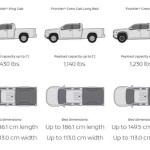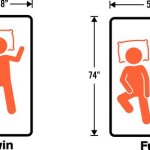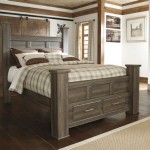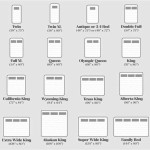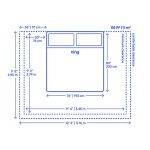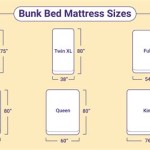Full Size Bed Bug Covers: Protecting Your Mattress and Ensuring a Peaceful Night's Sleep
Full size bed bug covers, also known as mattress encasements, are specialized bedding products designed to completely enclose a full-size mattress. Their primary function is to prevent bed bugs from infesting the mattress and box spring, as well as to trap existing bed bugs inside, eventually leading to their demise. These covers are a critical component of an integrated pest management strategy for bed bugs, offering a non-toxic and proactive method of control and prevention.
The effectiveness of a full-size bed bug cover hinges on its construction and material. High-quality encasements are manufactured with tightly woven fabrics and sealed zippers. This tight weave prevents bed bugs, which are typically about 1/4 inch long, from penetrating the material and accessing the mattress. The sealed zipper eliminates potential entry points along the zipper line, a common vulnerability in lesser quality products. Understanding the features and benefits of these covers is crucial for making an informed purchase and ensuring optimal protection.
Key Point 1: Understanding Bed Bug Behavior and the Role of Encasements
Bed bugs are nocturnal insects that feed on human blood. They are drawn to the carbon dioxide that humans exhale while sleeping. These pests are adept at hiding in cracks and crevices near their food source, making mattresses and box springs ideal harborages. Mattresses offer numerous seams, folds, and crevices that provide shelter and protection for bed bugs to breed and multiply.
Once a bed bug infestation takes hold, it can be incredibly difficult and expensive to eradicate. Bed bugs are resilient and can survive for months without feeding. They are also resistant to many over-the-counter insecticides. This makes prevention a much more desirable and cost-effective approach than dealing with an established infestation.
Full size bed bug covers address the root of the problem by denying bed bugs access to the mattress, their primary hiding place. By enclosing the mattress within a protective barrier, the encasement prevents new infestations from taking hold. Furthermore, if bed bugs are already present within the mattress, the encasement traps them inside, preventing them from escaping to feed. Deprived of a blood meal, these trapped bed bugs will eventually starve and die. This process can take several months, emphasizing the importance of leaving the encasement in place for an extended period, even after the visible signs of infestation have disappeared.
Beyond preventing and containing bed bugs, encasements also contribute to overall mattress hygiene. They protect the mattress from dust mites, allergens, spills, and stains, extending its lifespan and maintaining a healthier sleep environment. This is particularly beneficial for individuals with allergies or asthma.
Key Point 2: Essential Features to Look for in a Full Size Bed Bug Cover
Not all full size bed bug covers are created equal. The effectiveness of an encasement depends on several key features that must be carefully considered before making a purchase. These features ensure the cover provides a robust barrier against bed bugs and withstands the rigors of regular use.
Fabric Tightness and Pore Size: The most critical feature is the tightness of the fabric weave. The cover must have a pore size small enough to prevent bed bugs and their eggs from passing through. Look for fabrics with a pore size of less than 10 microns. Tightly woven fabrics like polyester or microfiber are often used. Check for certifications from independent testing organizations that verify the fabric's effectiveness against bed bugs. These certifications provide assurance that the cover has been tested and meets specific performance standards.
Zipper Quality and Closure: The zipper is another critical point of entry for bed bugs if not properly sealed. The encasement should feature a high-quality zipper that is durable and easy to operate. The zipper should also have a secure closure mechanism, such as a Velcro flap or a locking zipper, to prevent bed bugs from escaping or entering along the zipper line. Look for zippers that are specifically designed to be bed bug proof.
Water Resistance and Breathability: While the primary function is to prevent bed bugs, a good encasement should also offer some degree of water resistance to protect the mattress from spills and stains. However, it is also important that the fabric is breathable to allow for air circulation and prevent moisture buildup, which can lead to mold and mildew growth. Look for encasements that are labeled as both water-resistant and breathable.
Durability and Construction: The encasement should be made from durable materials that can withstand regular use and laundering. Reinforced seams and corners are important to prevent tearing and ripping. The encasement should also be designed to fit snugly around the mattress without being too tight or restrictive. A well-constructed encasement will last for several years, providing long-term protection against bed bugs.
Ease of Installation and Maintenance: Consider the ease of installing and removing the encasement. Some encasements have elasticized edges that make them easier to slip onto the mattress. The encasement should also be machine washable and dryer safe for easy cleaning and maintenance. Follow the manufacturer's instructions for laundering to ensure that the encasement retains its protective properties.
Key Point 3: Implementing a Bed Bug Management Strategy with Encasements
While full size bed bug covers are an essential tool in bed bug management, they are most effective when used as part of a comprehensive strategy. A holistic approach addresses all potential sources of infestation and prevents the spread of bed bugs to other areas of the home.
Visual Inspection: Before installing an encasement, thoroughly inspect the mattress, box spring, bed frame, and surrounding areas for signs of bed bugs. Look for live bugs, shed skins, fecal stains, and blood spots. Pay close attention to seams, folds, and crevices where bed bugs are likely to hide. Use a flashlight and a magnifying glass to aid in the inspection. If bed bugs are found, consider consulting with a professional pest control company for treatment options.
Treating Existing Infestations: If bed bugs are present, it is crucial to treat the infestation before installing the encasement. This may involve using insecticides, steam cleaning, or heat treatment. Vacuum the mattress and surrounding areas thoroughly to remove any loose bugs and eggs. Seal the vacuum bag tightly and dispose of it outside. It is also recommended to wash all bedding, including sheets, pillowcases, and blankets, in hot water and dry them on high heat. This will help to kill any bed bugs or eggs that may be present.
Encasement Installation: Once the mattress and surrounding areas have been treated, carefully install the encasement. Follow the manufacturer's instructions for proper installation. Ensure that the encasement fits snugly around the mattress and that all zippers are securely closed. Inspect the encasement regularly for any signs of damage or wear and tear. Replace the encasement if it becomes torn or damaged.
Monitoring and Prevention: Even with an encasement in place, it is important to continue monitoring for bed bugs. Regularly inspect the area around the bed for any signs of infestation. Take precautions when traveling to avoid bringing bed bugs home. Inspect luggage and clothing after traveling and wash them in hot water if necessary. Consider using luggage liners or sprays to deter bed bugs. Maintain a clean and clutter-free bedroom to reduce potential hiding places for bed bugs.
Box Spring Encasements: In addition to a mattress encasement, consider encasing the box spring. The box spring can also serve as a hiding place for bed bugs. Encasing both the mattress and box spring provides a comprehensive barrier against infestation.
By implementing a comprehensive bed bug management strategy that includes regular inspections, treatment of existing infestations, the use of high-quality full size bed bug covers, and ongoing monitoring, it is possible to protect your mattress and ensure a peaceful night's sleep. While professional pest control services are often necessary for established infestations, preventative measures like mattress encasements can significantly reduce the risk of future problems.

Alltopbargains Full Size Bed Mattress Cover Plastic White Waterproof Bug Protector Mites Dust

Remedy Bed Bug Dust Mite Cotton Mattress Protector Full

Full Size Mattress Cover Zipper Waterproof Plastic Bed Bug Dust Mites Allergens

Full Size Bed Mattress Cover Plastic White Waterproof Bug Protector Mites Dust

Full Size Mattress Cover Zipper Waterproof Plastic Bed Bug Dust Mites Allergens

Bedsure Cozy Comfort Mattress Protector Full Size Bed Bug Proof Cover 100 Waterproof For Zippered Encasement Six Sided 12 Inches Deep

The Original Bed Bug Proof Zippered Vinyl Mattress Covers Assorted Sizes

Reviews For Linen Studio Mattress Protector Full Microfiber Spill Proof Bed Bug Premium Zipper Encasement Pg 1 The Home

Stylewell Waterproof Allergen Bed Bug Resistant Fully Encased Full Mattress Protector Hd016 F White The Home

Continental Sleep Mattress Or Box Spring Zippered Waterproof Dust Mite Proof And Bed Bug Breathable Protector Cover Full Size


